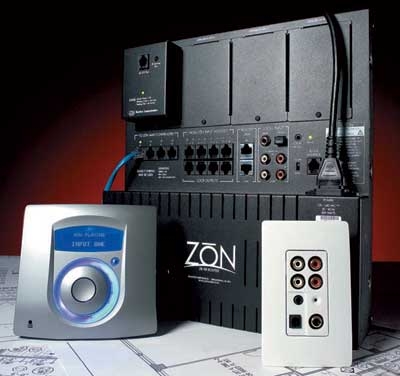Music Around the House Page 5
Oxmoor, a pro-audio specialist and former exclusive provider of sound and automation technology to Imax theaters, introduced its Z?N (say it like "zone") system in 2002. The base system provides control of nine music sources in four zones. 
The ZR-98 router that distributes the music doesn't resemble a traditional A/V component at all and is designed to be hidden away (shown above, $1,159). It works with ZIM-4 input modules (front right in photo, $498 a pair) and ZAC-60 "keypads" (front left, $599 each).
Practically alone among multiroom systems, Z?N is all-digital. You connect one source component to the router and one to each ZIM-4 module. Both offer optical and coaxial digital audio as well as analog inputs, but any analog input signals go to a 24-bit analog-to-digital converter built into the router and stay in the digital domain until the 30-watt-per-channel amps in the keypads send analog sigals to the speakers. The router has RJ-45 jacks for all connections with the input modules and the keypads. There's also a minijack for an IR emitter and an RJ-11 jack that serves as an RS-232 port for connection to a PC (necessary for programming), plus four bays for expansion modules.
At first glance, the ZAC-60 appears to have only a volume knob - an incredibly stylish, ultra-cool volume knob. It offers all the functionality of a traditional keypad, however, because the "knob" is a multifunction jog/wheel controller: Press it, and an input menu you can scroll through by turning the wheel appears in the blue-backlit LCD window; you press again to select one. Press and hold it briefly for a menu of other functions, including bass, treble, balance, and loudness adjustments as well as a choice among three preset equalization curves. Press and hold it for about 5 seconds to turn the keypad off.
When the ZAC-60 is on, a light blue glow surrounds the jog/wheel, the current source is shown in the window, and the current volume setting is indicated by a small blue light in the ring around the center of the wheel. Each keypad in the Z?N system also incorporates an intercom and comes with a wafer-thin remote control (not shown).
is virtually identical to that for the A-Bus system. Cat-5 wire runs from the ZR-98 router to each keypad and input module and speaker wire from the keypad to each speaker. Each keypad has spring-clip speaker connectors and an RJ-45 jack for the router connection.
is done on a Windows PC connected to the router using the Z?N Config software included with the system. Once the connection is established, basic setup takes about 10 minutes. You can label all the zones and inputs, and any inputs you aren't using can be eliminated to speed up the keypad selection process. You can also set whether a zone should receive pages, the paging volume, and whether certain sources (like a cable box) should be barred from certain zones, like a child's room.
Programming the system to control your source components requires the optional ZIR-232 Device Commander module (not shown, $239), which offers both IR and RS-232 system control. You install the module in one of the router's expansion bays - a simple procedure - and it'll then appear on the Z?N Config setup menu.
The ZIR-232 has an onboard library of control codes for thousands of components, so programming it might be as easy as selecting the type of component, the manufacturer, and the model number from a list. Of my three source components, two were in the database, but I had to "teach" the system its commands for the third. Once learning is complete, you assign graphical icons to each command.
For rooms that might require multiple speaker pairs or that need more power, the optional Direct Box ($149) allows the ZAC-60 to feed an external amp.
The Z?N system had plenty of volume and delivered better bass than the other Cat-5-based systems. The sound in each of my three zones seemed like it was coming from a conventional amplifier rather than a small digital amp crammed into a double-gang wall box. Music played through my CD player's digital output yielded more presence and a fuller, ultimately more pleasing sound than through its analog output, which the Z?N router converted to digital - though discs recorded at high levels distorted when I cranked the volume. While basic system control was pretty easy, it was tricky to issue more complex commands. Only six icons can appear at any time in the LCD window, so you have to "page" through many screens to access all of a component's functions. PDF: Fast Facts
- Log in or register to post comments



































































